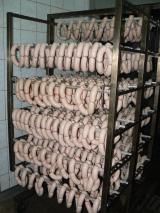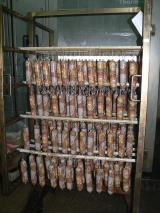In the continuation of the analysis of the subtleties and nuances of heat treatment of sausage and meat products, we came to the main - technological. Their consideration must begin with the correctness of hanging the sausage products on the frames on which the whole process of heat treatment takes place.
The most common error is excessive loading of the frame, which leads to an increase in the time of the heat treatment process, uneven color formation during the drying and smoking processes due to a decrease in the air circulating in the air chamber and the uneven heating of the products to cookery during cooking, which is the most dangerous and practically It is controlled by working thermo-separation, because Such products are usually in the middle of the frame and are difficult to control.
Optimum loading weight for one standard 2-meter frame for practically all heat-measuring chambers of different manufacturers used in meat processing is the following:
- boiled sausages, sardines in natural and collagen casings - up to 250 kg / frame;
- w / k and n / sa sausages with a diameter of 40-50 mm - up to 300 kg / frame;
- cooked sausages in polyamide or impermeable shells with the use of additional digestion or so-called. "Exposure" - up to 400 kg / frame.
These figures fully correspond to the technical and functional capabilities of thermal equipment and are most optimal in terms of the weight loss of products during heat treatment and energy consumption when the equipment itself operates.
There are also subtleties when loading sausage carts, when the products are small or one of the loadable frames is not complete. In this case, the obligatory condition for loading the frame is its horizontal rowing, i.e. the maximum number of medium tiers should be completely hung (see photo 1).
|
photo 1 |
photo 2 – Incorrect frame loading |
In this case, there are minimal changes in the uniformity and flow rate of the blown air in the heat chamber, which does not significantly affect the quality of heat treatment. Diagonal and non-uniform over the tiers load more strongly affect the aerodynamic properties of the air flow inside the thermal installation, thereby reducing the quality of the processes.
Next I would like to say a few words about the draft of sausages. Today's recipes, technologies and a lot of various additives make it possible to heat-treat the products immediately after filling with a syringe without problems. Without using sediment in sedimentary chambers. However, it is well known to all that when the product is sludge, especially the higher grades, the natural ripening of the meat makes it possible to obtain a better color formation during drying and smoking in a heat chamber. Shrinkage of meat sausage significantly increases the density of the product, at which it is possible to form the external appearance of the surface of the loaf from absolutely smooth to the so-called "herringbone" of varying degrees of "puckiness" by cooking parameters. As for sardles in natural grape, the recipes of which assume the use of only natural meat, our experience of heat treatment shows that without precipitation for at least 2 hours, they can dry out properly and get uniform color formation throughout the frame volume practically impossible.
The peculiarity of heat treatment of products that have undergone sediment is that before loading it directly into a thermal chamber it is desirable to hold it in some room or in the room of thermal separation for heating the product to at least 10-12 °C, especially if the sedimentation chambers have a temperature of 5-8 °C. There were cases when in the product, which had undergone sediment and a full cycle of heat treatment, there were dark inclusions (dots) under the shell. Evidently, at low temperatures, the salts formed in the spices crystallized, which dissolve more slowly in the product than the change in the color of the mince under the shell, which leads to this effect. It was possible to eliminate it by leaving the products for natural warming up in an ordinary room before heat treatment for 2 hours. The same positive result can be obtained if the heat treatment process begins with warming up in a thermal chamber at a temperature of 20-25 °C at low engine speeds until the product temperature reaches 13-15 °C, which is the starting temperature of traditional heat treatment processes.
Separately, I would like to draw attention to the thermal processing of sausages in multi-frame (from 4 frames) smoking-cooking plants. As a rule, they are used for multi-ton production of one type of product - monoproduct. If several padded lines are used to prepare the semi-finished product of such a product and the difference in time between the output of the first and the last frame does not exceed 1.5-2 hours, there will be no problems in heat treatment.
If this time is longer, it is necessary to control the temperature of the product on the first prepared frame and the last after packing. Depending on where the first prepared frames were - the sediment chamber or the workshop room - the product temperatures may differ significantly (sometimes up to 10 °C) from those that came out immediately after filling and clipping. Naturally, the processes of heat treatment of such products will not ensure the same heating of products, uniform color formation during drying and smoking and simultaneous achievement of the temperature of cooking readiness - 70-72 °C.
In this regard, we suggest to consider several recommendations for heat treatment of sausages, which will help to avoid deterioration in the quality and presentation of products.
First of all, it is necessary to equalize the product temperatures on all prepared frames with a semi-finished product. This can be achieved if the entire volume of products for 1.5-2 hours in a single room. This can be either a sedimentation chamber or a production hall. If this is not possible, and such products are loaded into the thermal chamber, it is necessary to pay attention to the fact that frames with a lower temperature are loaded last for installing a temperature control sensor in the product and visual control of the color formation, since the colder products will be processed somewhat longer.
The greatest effect in this situation can be obtained by using a smooth step heating at the first step of heat treatment, starting with a temperature close to the temperatures of the warmest semi-finished product - 20-25 °C. When such temperatures are set, it will be more intensive to warm up only the colder products before completely equalizing the whole volume of the heat chamber. This method will avoid the rapid warming up of warmer products, its overdrying and the acquisition of excessive color during drying and smoking, as well as higher rates of moisture loss.
To be continued...


